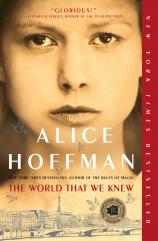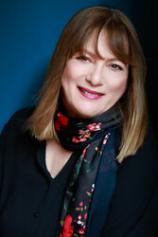Author Talk: September 25, 2019
In 1941, during humanity’s darkest hour, three young women must act with courage and love to survive. This is the premise of Alice Hoffman’s spellbinding new novel, THE WORLD THAT WE KNEW, which is set mainly in France during the Nazi occupation. In this interview, Hoffman discusses her inspiration for the book; how she used magic to reach the emotional heart of such a cruel time in history; the research she conducted, which included traveling to France and visiting the chateaus where Jewish children were sent when they were separated from their parents; the character in the novel who moved her the most; and her next project, which is sure to excite readers of her Practical Magic series.
Question: THE WORLD THAT WE KNEW is being called another Alice Hoffman masterpiece. What was the evolution of this novel?
Alice Hoffman: Years ago, I met a woman in Florida who asked me if I would write her life story. She had been a hidden child in France during the Holocaust, sent to a convent by her parents in an attempt to rescue her. She felt that if the story of the hidden children wasn’t told, it would be forgotten. I thought about what she had said for a very long time, and in 2016 I began to write THE WORLD THAT WE KNEW.
Q: Discuss how you used magic to reach the emotional heart of such a cruel time in history.
AH: So many novels have been written about the Holocaust that I felt I wanted to tell a story from a different point of view. I approached this time of destruction as a dark fairy tale. It was a time when nothing made sense, and although I most often write to make sense of things, doing so was impossible given the circumstances. As a friend who is a historian wrote, “History is luck.” Who gets on a train and who doesn’t can change everything. We can control our choices and our reactions, but we can’t control fate. I was most interested in writing about the emotional lives of the characters, how they dealt with grief and sorrow, and how they continued to find joy in life.
Q: How do you conduct research that results in such a rich and detailed story?
AH: I always do a huge amount of reading, but for this novel I wanted to see the landscape of the novel for myself and met people who had been directly affected by the history I was writing about. I traveled to France and visited the chateaus where Jewish children were sent when they were separated from their parents. (At first, only foreign Jews were deported, then Jews over the age of 16, so that parents and children were separated. In the end, all Jews, including infants, were deported.)
I was fortunate to meet several child survivors in France, now in their 80s and 90s, and several in the United States, all of whom were so generous in sharing their stories with me. I was in awe of the survivors I spoke with, and although I am not telling the story of their lives, the emotions they shared with me were very moving and affected me greatly.
Q: Do you see similarities between the time period in THE WORLD THAT WE KNEW and the world we're currently living in? What can we do to combat hatred?
AH: In France, the political situation began with a hatred and fear of refugees, then of Jewish refugees, then of all Jews. Hatred starts small and grows larger when it’s ignored. When people are bystanders, it grows even larger, and before long it is out of control.
I think that, unfortunately, there are many parallels between what happened in Europe in the 1930s and ’40s and what is happening in our country now, both at the border and throughout the states. It’s so important to speak out and to remember the stories of the past. We have to remember the cost of hatred and the importance of fighting for a world in which everyone has rights.
Q: Was there a character with a past who moved you most?
AH: The mother superior, Sister Marie, who was born Madeleine de Masson into an Algerian Jewish family who changed both their name and their religion so they would fit into French culture. Her story, her deep love for her grandfather, and her conviction that she must do good in the world always moves me and makes me feel grateful that despite the horrors in the world, there will always be people who are compelled to do the right thing.
Q: Did writing a novel set in such a tragic time affect you while you were working on the book? How did you transform sorrow into a work of beauty?
AH: I always start a novel with a question. With THE WORLD THAT WE KNEW, my question was How do survivors of tragedy manage to go on? I found my answer when speaking with survivors in this country and in France. Even those who had suffered enormous loss valued life, wanted to live, and found joy in their families, their work, their memories and their daily lives.
I do think all artists and writers have a similar goal: to spin straw into gold, to make something beautiful out of dust and ashes.
Q: There are many different types of love in the novel. The power of a mother’s love is particularly moving. Can you tell us about your own relationship with you mother?
AH: My relationship with my mother and grandmother is likely at the heart of this book. There isn’t a day when I don’t think of them. They influenced my life more than anyone. My grandmother told me my first stories and encouraged me when I wanted to be a writer. My first story was about her, and it was the story that made it possible for me to go to the Stanford University [Creative] Writing Program. My mother was an unusual, beautiful and eccentric person, a lover of books and theater. I do believe that the loss of one’s mother changes everything. No matter how old you are when it happens, you are an orphan.
Q: Ava is an intriguing character who makes us question what it means to be human. Did her story surprise you, and did she change during the writing of the novel?
AH: I never know what characters in a novel will do. I think I understand them, but in the process of writing, I grow to understand them at a deeper level. Ava changed because of her experiences, and because she knew love. I didn’t expect her to wish to be human --- if anything, I thought she was lucky to be “superhuman.” But in loving a child, she became human. It was beyond choice. It was her fate.
Q: You’ve spoken before about the inspiration you find in fairy tales. Were they an inspiration for this story, and if yes, how so?
AH: My earliest readings were fairy tales, myth, fantasy and science fiction. I do believe that what you read as a child affects you hugely as a person and as a writer. Fairy tales are so psychologically true, more so than any other literature, and children can sense their emotional depth. These stories are often a guide through sorrow to joy, with instructions on how to navigate the world. For me, they are the original literature, told by grandmothers to grandchildren.
THE WORLD THAT WE KNEW is also about navigating through a tragic time, and I thought of it as a story told by a mother and grandmother to a daughter, a cautionary tale and an instruction on how to survive.
Q: Can you tell us what you’re working on now?
AH: I’m working on the third book in my Practical Magic series. The second book is a prequel called THE RULES OF MAGIC, which takes place in New York City in the 1960s. The third book is about Maria Owens, the original ancestor of the family, in the 1600s. It’s been great fun to be back with the Owens family and to discover their secrets.








